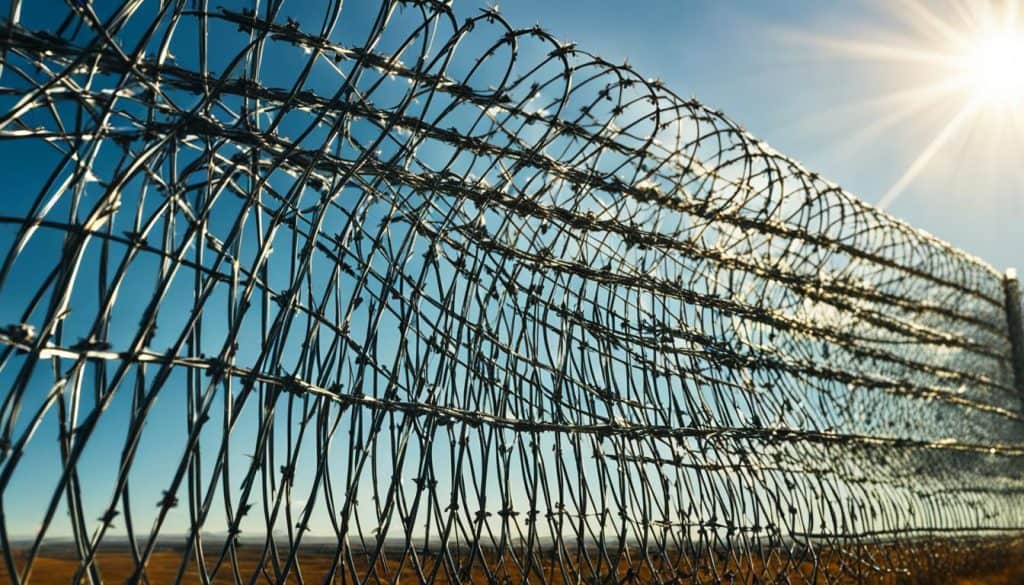When it comes to securing properties and assets, individuals and organizations are constantly on the lookout for effective security measures. One such option that often comes to mind is barbed wire. But can you use barbed wire for security purposes? In this article, we will delve into the world of barbed wire security applications and explore its effectiveness in various settings.
Key Takeaways:
- Barbed wire can be used as a security measure in different applications.
- It is important to understand the risks and considerations associated with barbed wire security.
- Proper installation and maintenance are crucial for the effectiveness of barbed wire security systems.
- Choosing the right type of barbed wire is essential for specific security needs.
- Barbed wire offers affordability, visibility, and low maintenance requirements as advantages.
Barbed Wire as a Perimeter Defense
When it comes to securing properties and assets, barbed wire is often considered an effective perimeter defense system. Its robust construction and deterrent properties make it a popular choice for many security applications. By installing barbed wire along the perimeter, property owners can create an additional layer of security that helps deter unauthorized access.
Barbed wire perimeter security is widely utilized in various settings, including industrial sites, government facilities, agricultural areas, and private residences. Its sharp, protruding barbs act as a physical barrier, making it difficult for intruders to breach the perimeter. The presence of barbed wire sends a clear message that the property is protected, dissuading potential trespassers.
One of the key advantages of using barbed wire for perimeter defense is its effectiveness in deterring unwanted entry. The sight of barbed wire acts as a powerful visual deterrent, discouraging unauthorized individuals from attempting to breach the security perimeter. Its sharp barbs also pose a physical risk, further deterring potential intruders.
Moreover, barbed wire is a cost-effective security solution compared to other alternatives. The installation and maintenance costs of barbed wire are relatively low, making it an accessible option for various budgets. Furthermore, the durability and longevity of barbed wire ensure long-term protection without the need for frequent repairs or replacements.
While barbed wire as a perimeter defense system offers numerous benefits, it is essential to ensure proper installation and adherence to local regulations. Installing barbed wire at appropriate heights, using compatible posts and supports, and regularly inspecting and maintaining the system are crucial for its effectiveness. Additionally, property owners should consider signage and warning labels to comply with safety regulations while clearly indicating the presence of barbed wire.
Installing Barbed Wire: Best Practices
Proper installation of barbed wire is crucial for creating an effective and reliable security system. By following the best practices outlined below, you can ensure the optimal performance of your barbed wire installation.
1. Use High-Quality Materials: Choose barbed wire made from durable materials that can withstand weather conditions and potential tampering. High-quality wire will offer long-lasting security.
2. Determine the Height and Spacing: The height and spacing of your barbed wire will depend on the level of security required and the type of perimeter you are enclosing. Consult local regulations to ensure compliance.
3. Prepare the Area: Clear the area of any obstructions, vegetation, or debris that may interfere with the installation of the barbed wire. This will ensure a smooth and secure installation process.
4. Install Proper Supports: Use sturdy posts, brackets, or fence panels to support the barbed wire. Ensure that the supports are firmly anchored to the ground to prevent sagging or damage.
5. Use Tensioning Tools: Properly tension the barbed wire to ensure it is securely attached to the supports. Tensioners, tighteners, or strainers can help achieve the necessary tautness for maximum effectiveness.
6. Employ Safety Precautions: Wear protective gloves and eyewear when handling barbed wire to minimize the risk of injuries. Exercise caution and follow all safety guidelines throughout the installation process.
7. Regular Maintenance: Periodically inspect your barbed wire installation for signs of wear, damage, or loosening. Proactive maintenance will help ensure the continued effectiveness of your security system.
By adhering to these best practices, you can install barbed wire that provides reliable security and acts as a deterrent to potential intruders.
Choosing the Right Barbed Wire for Security
When it comes to using barbed wire for security purposes, selecting the correct type is crucial to ensure optimal effectiveness. In this section, we will explore the different options available and provide key considerations to keep in mind when choosing the right barbed wire for your specific security requirements.
Barbed wire comes in various configurations, each with its own unique characteristics and applications. The two most common types are traditional twisted wire and concertina wire. Traditional twisted wire consists of two twisted strands with sharp barbs evenly spaced along the wire. Concertina wire, on the other hand, is formed by wrapping two lines of twisted wire together, creating a coil-like structure with sharp barbs protruding in all directions.
Before making a selection, it is important to assess your security needs and the level of deterrence required. Factors to consider include the area to be secured, the potential threats you may face, and any specific regulations or standards that need to be met. Additionally, the visibility of the wire and its compatibility with other security systems should also be taken into account.
Another consideration is the size and gauge of the wire. The size of the wire refers to the diameter of the individual strands, while the gauge represents the thickness of the wire. Thicker wires generally offer greater strength and durability but may also be more challenging to install. It is crucial to strike the right balance between strength and ease of installation based on your security needs.
When selecting barbed wire, it is advisable to consult with security professionals or industry experts who can provide guidance based on their experience and knowledge. They can help evaluate your specific security needs and recommend the most suitable barbed wire options.
Overall, choosing the right barbed wire for security requires careful consideration of various factors, including the type of wire, its visibility, compatibility with existing security systems, and the expertise of professionals. By taking these factors into account, you can ensure that your barbed wire security system is effective and provides the desired level of protection.
Effectiveness of Barbed Wire in Different Security Strategies
Barbed wire is not limited to just perimeter defense; it can be utilized effectively in various security strategies. Its versatility makes it suitable for securing sensitive areas, controlling access, and creating temporary security installations. Let’s explore how barbed wire can be a valuable component in these security applications.
Securing Sensitive Areas
When it comes to securing sensitive areas, barbed wire acts as a visual deterrent and provides physical barriers that are difficult to breach. Whether it’s protecting high-security facilities, critical infrastructure, or confidential locations, barbed wire enhances security by creating a formidable obstacle that discourages unauthorized entry.
Access Control
Barbed wire can be integrated seamlessly into access control systems to enhance security at entry and exit points. By installing barbed wire fencing in your backyard and front yard gates, controlled access can be achieved, ensuring that only authorized personnel can enter restricted areas. This not only prevents trespassing but also helps in managing and monitoring the movement of individuals for enhanced security.
Temporary Security Installations
In situations that require temporary security measures, such as construction sites, public events, or disaster response areas, barbed wire proves to be a cost-effective and efficient solution. It can be quickly installed and dismantled as needed, providing a temporary but effective barrier to deter unwanted access or protect valuable assets.
Barbed wire’s flexibility as a security measure extends beyond traditional perimeter defense. Its applications in securing sensitive areas, access control, and temporary installations make it a versatile choice for a wide range of security strategies.
Understanding the Risks and Considerations
While barbed wire can be an effective security measure, it is crucial to understand the potential risks and considerations associated with its use. Implementing barbed wire for security purposes requires careful planning and adherence to safety regulations. This section will provide an overview of the key factors to consider when utilizing barbed wire as a security solution.
Risks of Barbed Wire Security
Barbed wire poses potential risks to both intruders and authorized personnel. Its sharp and pointed edges can cause injuries, including cuts, punctures, and abrasions. In situations where accidental contact occurs, the risk of injury significantly increases. It is important to implement appropriate warning signs and safety measures to minimize the possibility of accidents.
Additionally, barbed wire may present a legal liability if not installed and maintained correctly. Failure to comply with local laws, regulations, and safety standards can result in legal consequences. It is essential to consult with legal professionals and security experts to ensure legal compliance with your barbed wire installation.
Considerations for Barbed Wire Security
Before installing barbed wire, it is crucial to consider the surrounding environment and potential impact on individuals, animals, or property. Here are some important factors to take into account:
- Neighboring Properties: Ensure that the installation of barbed wire does not encroach on neighboring properties or create hazards for adjacent buildings or structures.
- Public Accessibility: If the property is accessible to the public, consider the potential risks and legal requirements for installing barbed wire in public areas.
- Wildlife and Animals: Take into consideration the presence of wildlife, domestic animals, or livestock that may come into contact with the barbed wire. Implement measures to prevent harm to animals and minimize the risk of entanglement.
- Maintenance and Inspections: Regularly inspect and maintain the barbed wire to ensure its effectiveness and durability. Monitor for signs of wear and tear, damage, or tampering.
By understanding these risks and considerations, individuals and organizations can make informed decisions about implementing barbed wire security. It is crucial to assess these factors and take appropriate safety measures to protect both the property and the individuals involved.
Benefits of Using Barbed Wire for Security
Barbed wire is an efficient and cost-effective security measure that offers several unique advantages. When it comes to safeguarding your property, barbed wire can provide the protection you need. Let’s explore the benefits of using barbed wire for security:
Affordability: One of the major benefits of barbed wire is its affordability. Compared to other security options available in the market, barbed wire is relatively inexpensive to install and maintain. This makes it a practical choice for both residential and commercial properties.
Visibility: Barbed wire serves as a visible deterrent to potential intruders. Its sharp and distinct appearance sends a clear message that your property is protected. The visibility of barbed wire acts as a psychological barrier, deterring unauthorized access and minimizing security risks.
Low Maintenance Requirements: Another advantage of barbed wire is its low maintenance requirements. Once properly installed, barbed wire requires minimal upkeep, saving you time and effort. Regular inspections and occasional repairs can ensure the long-term effectiveness of your security system.
Protection and Deterrence: Barbed wire provides an additional level of protection to your property. Its sharp and threatening design acts as a physical barrier, making it difficult to breach. The presence of barbed wire can deter potential intruders, reducing the likelihood of unauthorized access.
Conclusion
In conclusion, the decision to use barbed wire for security hinges on various factors, including local regulations, property type, and the desired level of deterrence. While barbed wire can be effective in certain situations, it’s crucial to weigh its pros and cons carefully.
For those considering barbed wire installation, Los Angeles Fencing Co. offers expert services that prioritize both security and aesthetic considerations. Their skilled professionals ensure a meticulous and compliant installation, addressing your specific security needs while maintaining a visually appealing and safe environment. Explore the possibilities with Los Angeles Fencing Co. for a secure and well-crafted solution tailored to your property.



